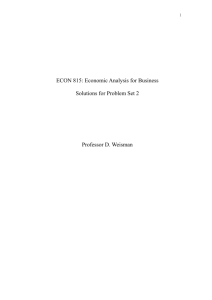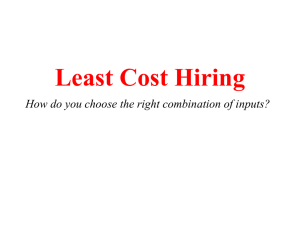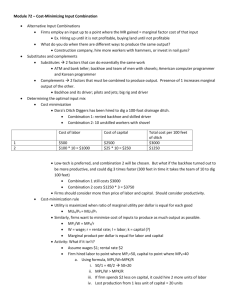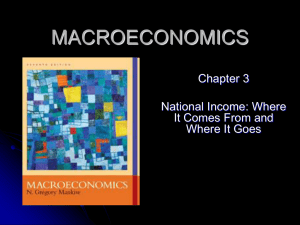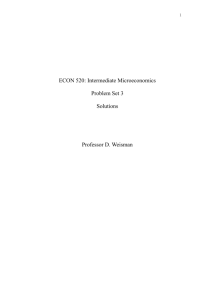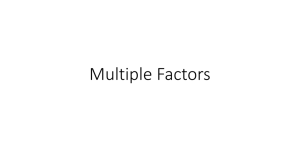OSNOVE EKONOMIJE
advertisement
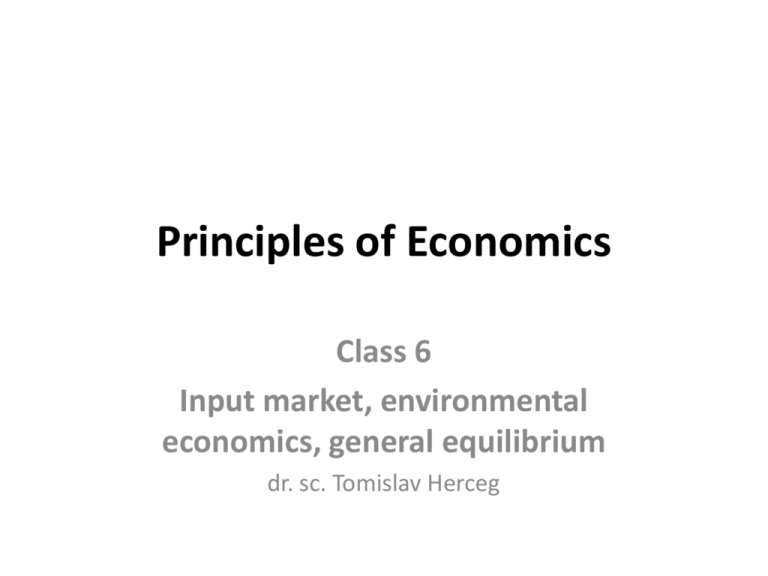
Principles of Economics Class 6 Input market, environmental economics, general equilibrium dr. sc. Tomislav Herceg Income • Incomes: 1. Wages (price of labour) 2. Rent (price of land) 3. Interest rate (price of capital) 4. Dividend (price of capital) 5. Transfer payments (gifts) • Distribution of goods is based on the ability to pay for those goods 2 Input markets • Demand for inputs is deducted from demand for products and is equal to MRP • Market demand is obtained by horizontal summation of individual demands. • Marginal revenue product (MRP) is the additional revenue when an additional unit of input is employed: MRPK = MR×MPK, MRPL = MR×MPL , MRPN = MR×MPN • In perfect competition when MR = P we have: MRPK = P×MPK, MRPL = P×MPL , MRPN = P×MPN 3 Demand for labour • Demand for labour is MRPL, which shows how revenues increase when additional worker is employed). • MRPL = MPL×MR, u s.k. MRPL = MPL×P • In p.c. w = MRPL= MPL×P →MPL = w/P (marginal product of labour equals real salary) w Demand for labour MRPL = d 0 L 4 Demand for capital and land • Demand for land is MRPN, which shows how revenues increase when additional unit of land is employed). • Demand for capital is MRPK, which shows how revenues increase when additional unit of capital is employed). • MRPN = MPN×MR, in p.c. MRPN = MPN×P • MRPK = MPK×MR, in p.c. MRPK = MPK×P 5 Profit maximization on the input markets MR = MC MR×MPL = MC×MPL = w MR×MPL = w Since in p.c. MR = P then P×MPL = w In perfect competition the following holds: P×MPK = r, P×MPN = rN P×MPL = PL MPL /PL = 1/P • The same holds for other inputs too: MPL /w = MPK /r = MPN /rN = 1/P →Minimum cost rule 6 Supply of inputs • Labour supply depends on w and demographic structure • Land supply depends on geography and rN. • Capital supply depends on r and expected return • Market supply is obtained by horizontal summation of individual supplies. • Equilibrium supply and demand is obtained on the intercept of the input supply and demand • The price of input is equal to the MRP of the last employed unit of input 7 Individual and market supply for labour • Worker decides how many hours a day (24h) he wants to work, depending on the wage (w). • WORKFORCE = unemployed seeking job + employed • Substitution effect: the increase in salary increases the number of working hours • Income effect: when the income is high enough workers start to work less to be able to enjoy their money. w SL 0 L 8 Labour market equilibrium w SL DL 0 D’L L 9 Capital market equilibrium r r SK r SK SK DK 0 K Short run DK DK 0 K Medium run 0 K Long run • Capital supply increases in time 10 Land market equilibrium rN SN DN 0 N • Land supply is fixed!! 11 RENTABILITY OF INVESTMENT • • • Profitability of an investemnt is estimated using 𝑹 Return on capital indicator 𝑹𝑶𝑪 = where R is 𝑰 the annual return, and I initial investment. Interests are reward for savings Nominal interest rate is a money return, and real interest rate is a nominal rate corrected for inflation: 𝑖+100 100+𝜋 𝑟= − 1 ×100% 𝑟 ≈𝑖−𝜋 12 Present value of an asset • Present value (V) is a sum of all returns doiscounted 𝑅𝑖 𝑛 for the interest rate: 𝑉 = 𝑡=1 𝑡. 1+𝑖 • Permanent rent is an investment that yield the infinite 𝐼0 number of payoffs Io: 𝑉 = 𝑖/100 • All costs and benefits of an investment are estimated in the cost-benefit analysis • Investment projects will be undertaken if 𝑅𝑂𝐶 ≥ 𝑖 + 𝜋 + 𝑅𝑃, where i is a nominal interest rate, 𝜋 inflation and RP is a risk premium. • If 𝑅𝑂𝐶 < 𝑖 + 𝜋 + 𝑅𝑃 then it is better to put the money in the bank. 13 • 5) a company has to decide which machine to buy. There are 3 offers for 3 different machines which have the following returns: YEAR RETURN A 1 2 3 4 5 • • • • • • • • • • RETURN B 300 250 200 150 100 RETURN C 350 250 200 200 If i = 10% which offer is the best? Machine A V = N1/( 1+i ) + N2/( 1+i )2 + N3/( 1+i )3 + N4/( 1+i )4 + N5/( 1+i )5 V = 794.1459537 ~ 794.15 Macine B V = 350/1.1 + 250/1.12 + 200/1.13 + 200/1.14 V = 811.6590335 ~ 811.66 Machine C V = 400/1.1 + 300/ 1.12 + 300/ 1.13 V = 836.9646882 ~ 836.96 =>The best offer: C >B>A 400 300 300 • 6) Rent-a-car company bought several cars at price 68 000 kn per car, and rents them for 25 000 kn per year. If the annual depreciation is 6800 kn, insurance 5400 kn and maintenance costs 6200 kn per annum, find ROC. • P = 68 000 kn, Dp = 6800 kn, Ins= 5400 kn, Main.=6200 kn ; • • Total costs= 6800 + 5400 + 6200 = 18 400 kn Total revenue = 25 000 kn TR – TC = 6600 kn • ROC = 6600 / 68 000 = 9.7 % • General Equilibrium Analysis • GEA investigates relations between all the markets and how a simultaneous equilbrium can be obtained. • GEA is based on Pareto efficiency • Pareto efficiency is a situation when an increase in utility of one person decreases utility of others, or when an increase in production of one good decreses production of other goods. Conditions for Pareto efficiency 1. 𝑀𝑅𝑆𝑥𝑦 = 𝑀𝑈𝑥 𝑀𝑈𝑦 2. 𝑀𝑅𝑇𝑥𝑦 = 𝑀𝐶𝑥 𝑀𝐶𝑦 3. 𝑀𝑅𝑇𝑆𝑖𝑗 = 𝑀𝑃𝑖 𝑀𝑃𝑗 = 𝑝𝑥 𝑝𝑦 (for all products x and y) = 𝑝𝑥 𝑝𝑦 (for all products x and y) = 𝑤𝑖 𝑤𝑗 (for each input i and j) Edgeworth box (consumption) 𝑀𝑈𝑥 𝑝𝑥 = 𝑀𝑈𝑦 𝑝𝑦 (contract curve) 𝑀𝑅𝑆𝑥𝑦 = 𝐵 𝑢1 𝐵 𝑢2 𝐴 𝑢3 xj 𝐴 𝑢2 𝐵 𝑢3 𝐴 𝑢2′ 𝐴 𝑢1 xi Edgeworth box (production) 𝑀𝑃𝑖 𝑤𝑖 = 𝑀𝑃𝑗 𝑤𝑗 𝐵 𝑢 1 (contract curve) 𝑀𝑅𝑇𝑆𝑖𝑗 = 𝐵 𝑢2 𝐴 𝑢3 xj 𝐴 𝑢2 𝐵 𝑞3 𝐴 𝑢2′ 𝐴 𝑢1 xi PPF curve in general equilbrium qy 𝑀𝑅𝑇𝑥𝑦 = 𝑀𝐶𝑥 𝑝𝑥 = 𝑀𝐶𝑦 𝑝𝑦 u PPF px/py qx Environmental economics • Malthus (18.st.): population will increase faster than food production (it appeared to be wrong) • Development is impossible without the impact on the environment: Pollution per inhabitant GDP per inhabitant 21 Natural resources • Renewable n.r. can be used infinitely if preserved (forests, rivers, lakes, sea) • Non-renewable n.r. are limited or slowly renewable. • Externalities can be positive (the action of an individual causes benefits to the others, like vaccination) or negative (the action of an individual causes costs to the others, like pollution) • Internalization of externalities is a process of including extern costs in the individual costs by charging an ecological tax. 22 Negative externalities and taxes MSC = MEC + MC p Externalities’ control: 1. Law 2. Environment tax MC = s E F MEC p=d q 23 Problems 1) The government made an analysis of the SO2 pollution decrease. The data on costs and benefits are in the table: % decrease in the SO2 level Total social benefit 0 10 20 30 40 50 60 70 80 90 100 0 180 350 510 660 800 930 1050 1160 1260 1350 Marginal social benefit Total social costs 0 60 140 240 360 500 660 840 1040 1260 1500 a) Fill the table b) What is the most efficient level of SO2 reduction? Marginal social costs Net benefit • Solution: % decrease in the SO2 level Total social benefit 0 10 20 30 40 50 60 70 80 90 100 0 180 350 510 660 800 930 1050 1160 1260 1350 Marginal social benefit Total social costs 180 170 160 150 140 130 120 110 100 90 0 60 140 240 360 500 660 840 1040 1260 1500 Marginal social costs 60 80 100 120 140 160 180 200 220 240 Net benefit 0 120 210 270 300 300 270 210 120 0 -150 • The most efficient result will be obtained when SO2 level is reduced by 50% (MSB = MSC) 2)One ton of steel costs a steel factory 100 $. It also causes 5$ pollution costs. Find MEC, MSC and MC. • MC=100 $ • MEC = 5$ • MSC = 105$
